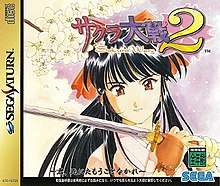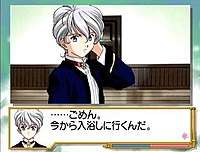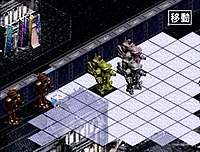Sakura Wars 2: Thou Shalt Not Die
| Sakura Wars 2: Thou Shalt Not Die | |
|---|---|
 Cover art for the original Sega Saturn release, featuring protagonist Sakura Shinguji | |
| Developer(s) | |
| Publisher(s) | Sega |
| Director(s) | Shinichi Ito |
| Producer(s) | Oji Hiroi |
| Artist(s) | |
| Writer(s) | Satoru Akahori |
| Composer(s) | Kohei Tanaka |
| Series | Sakura Wars |
| Platform(s) | Sega Saturn, Dreamcast, Microsoft Windows, PlayStation Portable |
| Release | |
| Genre(s) | |
| Mode(s) | Single-player |
Sakura Wars 2: Thou Shalt Not Die[lower-alpha 1] is a video game co-developed by Red Company and Sega CS2 R&D for the Sega Saturn. The second entry in the Sakura Wars series, it was published by Sega in 1998 and later ported to other systems, including to the Dreamcast in 2000. Defined as a "dramatic adventure" game, Sakura Wars 2 combines overlapping tactical role-playing, dating sim and visual novel gameplay elements.
Taking place two years after the events of the original Sakura Wars, Imperial Army Ensign Ichiro Ogami returns from training overseas to rejoin the all-female Flower Division of the Imperial Assault Force, a military unit dedicated to fighting supernatural threats against Tokyo while maintaining their cover as a theater troop. The Flower Division is caught up in a new supernatural battle and pressure from hostile political forces.
Development of Sakura Wars 2 began development following the critical and commercial success of the first game, with returning main staff including series creator Oji Hiroi, director Shinichi Ito, artists Kōsuke Fujishima and Hidenori Matsubara, writer Satoru Akahori and composer Kohei Tanaka. The game's subtitle was taken from a famous war poem by Japanese writer Akiko Yosano, and the anime sequences were created by Production I.G. The game went on to become the best-selling entry in the series, and was positively reviewed by critics. A direct sequel, Sakura Wars 3: Is Paris Burning?, was released for the Dreamcast in 2001.
Gameplay


Sakura Wars 2: Thou Shalt Not Die is set in Tokyo during a fictionalized version of the Taishō period, with players taking the role of Ichiro Ogami and the all-female "Flower Division" of the Imperial Assault Force. Dubbed a "dramatic adventure" game and taking place across multiple episodes, the gameplay segments incorporate tactical role-playing, dating sim and visual novel elements.[1][2] Gameplay is divided between periods where Ogami navigates the Imperial Theater and interacts with various characters, and combat sequences governed by a turn-based battle system upon a tilted grid-based battlefield.[2][3]
During the social sections between battles, Ogami navigates the theater. During interactions with both the Flower Division and supporting characters within the Imperial Assault Force, conversations relies on the series' LIPS (Live & Interactive Picture System) system, in this game dubbed "Double LIPS". When faced with critical choices in the course of a conversation, dialogue options are displayed with a time limit for the player to select a response. Depending on the type of response, the character may respond positively or negatively, impacting their relationship with Ogami and future interactions. The strength of each character's bond with Ogami is represented by a bar below the dialogue box. In addition to normal LIPS segments, Ogami can engage in conversations with multiple characters, the result of which also impacts character relationships, and new responses appearing mid-conversation depending on earlier choices. Other actions within LIPS include holding the cursor over parts of a character's portrait to trigger internal monologues and varying responses from the characters.[2][4] Each main heroine has different personality quirks that must be taken into consideration while talking with them.[5]
During combat segments, the Flower Division fight using machines called Koubu. Each unit has their own turn, with each turn allowing two actions. These actions include "Attack", "Defend", "Move", "Deathblow" (a critical strike that kills an enemy in one hit), Charge (store energy for a more powerful action during the next turn), and Heal (which restores health points to a chosen unit). Different units specialize in different skills, such as support actions, melee attacks, or distance attacks—along with their range of movement, each unit also has an independent range in which they can perform actions. Each unit's critical strike is accompanied by a dedicated cinematic. The player can also issue Commands in battle to make the Flower Division take specific battle formations, and two units can pair up for a powerful attack on a single enemy. Actions taken during LIPS sequences with members of the Flower Division directly impact battles; skillful performances during LIPS segments raise a character's Motivation, granting status increases and improving combat ability.[2][3][4][5]
Synopsis
Sakura Wars 2 takes place in Tokyo two years after the events of Sakura Wars. Having returned from training overseas, Imperial Army Ensign Ichiro Ogami reunites with his companions in the Imperial Assault Force's Flower Division, a section of the Imperial Army who use their spiritual power to defend Tokyo from supernatural threats while also performing as a theater troop. Soon after Ogami's return, the Flower Division are confronted by a group of black magicians dubbed the Black Demons, led by their earlier nemesis Aoi Satan. Satan is revealed to be Shinnosuke Yamazaki, a former comrade of Imperial Assault Force commander Ikki Yoneda from earlier conflicts with demons who was presumed killed but in fact corrupted by evil forces. The group defeat Yamazaki, who is then killed by the Black Demons' true leader, a masked man dubbed the Demon King. The Flower Division recruit two new members during their fight—the aristocratic Japanese-Italian Orihime Soletta, and the emotionally-distant Reni Milchstrasse.
During their continued efforts against the Black Demons, Yoneda is shot by a sniper and incapacitated. While he recuperates, Yoneda' place is filled by Kaede Fujieda, sister of Sakura Wars protagonist Ayame Fujieda. With its position weakened, the Imperial Assault Force come under political pressure from a military faction opposed to their existence. The faction is led by Keigo Kyogoku, a former Imperial Army officer turned formidable and callous politician. Kyogoku is revealed as the secret leader of the Black Demons, and the Flower Division are forced into hiding when Kyogoku launches a military coup d'état against Tokyo's government and the group's theater base.
As the Imperial Assault Force continue to fight against the Black Demons, they learn that Kyogoku has orchestrated events to reactivate a dormant magical weapon and rule as Japan's emperor. The Flower Division, supported by Yoneda and Kaede leading the remains of the Imperial Assault Force, launch an assault on the weapon. Sakura faces off against the Demon King himself—his defeat reveals him to be Sakura's resurrected father Kazuma Shinguji. The combined power of Sakura and Ichigo disables the weapon, and the Imperial Assault Force then destroy Kyogoku. Following a promotion to Lieutenant in honour of his actions, Ogami is sent overseas to train a new Assault Force.
Development
The original Sakura Wars was considered an ambitious project, and many of its core staff did not think would be a commercial success. Upon release, however, it was both a critical and commercial success. In response to the game's success, Sega and series creator Red Company began expanding Sakura Wars into a franchise, which included producing a sequel.[6][7] The game was co-developed by Red Company and Sega CS2 R&D, who had produced the original game. Oji Hiroi returned as producer, Shinichi Ito as director, Satoru Akahori as writer, Hidenori Matsubara and Kōsuke Fujishima as the character designers, and Kohei Tanaka as composer.[2][7] Takaharu Terada, who would later work on the PlayStation 2 remake of Sakura Wars, acted as battle designer.[8]
The development team used the basic work done for Sakura Wars while expanding and improving existing battle and dialogue functions, in addition to taking player feedback into consideration while making alterations. The amount of added content resulted in the number of discs increasing from two to three. The main storyline was darker than that of Sakura Wars, featuring political elements and more tragic scenarios related to the main cast. Kyogoku's attempted coup was based upon the February 26 Incident.[7] The game's subtitle was taken from the title of a famous anti-war poem written by Japanese author and poet Akiko Yosano, tying into the game's themes and story.[7][9]
The entire main cast returned to reprise their roles from the first game.[10] This included Ai Orikasa, who had voiced the character Ayame Fujieda—who died during the events of the first game—and returned playing Ayame's twin sister Kaede. After finishing recording Ayame's part for Sakura Wars, Orikasa assumed she would not be used for future games, so was surprised when asked to return.[11] Two new cast members were added in the form of Orihime and Reni, voiced respectively by Maya Okamoto and Kazue Ikura.[10] Ikura received an audition paper for the role asking for someone who could play a boy's role, perform songs and read musical notation.[12] The anime cutscenes were created by studio Production I.G. Sakura Wars 2 was their first work on the Sakura Wars series.[13][14] The opening theme was a new version of the first game's opening "Geki! Teikoku Kagekidan", sung by Sakura's voice actress Chisa Yokoyama. The ending theme, "Continuation of the Dream", was sung by the entire female cast.[15]
Release
Sakura Wars 2 was first announced in October 1997.[16] The game was released for the Sega Saturn on April 4, 1998. A later port for the Dreamcast released on September 21, 2000.[17] It was later ported to Microsoft Windows personal computers (PC). It was released for Windows 95, Windows 98 and Windows ME systems on March 1, 2001; and for Windows 98, Windows Me, Windows 2000 and Windows XP on March 20, 2003.[17][18] Due to the game's size, these versions were released on multiple CD-ROMs.[19] The CD-ROM version was localized and released in Russia on December 24, 2008.[20] A DVD-ROM version was released for Windows 2000, Windows XP and Windows Vista on January 25, 2007.[17][19] It was ported with the original game to the PlayStation Portable (PSP) and released on March 9, 2006.[21] Wider localization efforts for the series were prevented due to Sega's uncertainty as to whether the game's blend of genres would find a profitable audience outside Japan.[22] An attempt to localize the game's PSP port by an unspecified company were halted when Sony refused to approve the project.[23]
Reception
| Reception | ||||||||
|---|---|---|---|---|---|---|---|---|
| ||||||||
During its first week on sale, Sakura Wars 2 sold over 355,000 units, selling through nearly 70% of its shipments. Its total sales during 1999 reached over 509,000 units, going on to become the fifth best-selling Saturn title of all time in Japan.[26] During its first week on sale, the Dreamcast port sold over 63,000 units, selling through nearly 70% of its shipments. As of 2004, the port has sold just over 90,000 units.[27] As of 2008, Sakura Wars 2 is the best-selling video game in the Sakura Wars series.[28]
Japanese gaming magazine Famitsu gave the game a score of 33/40, with the title generally receiving praise for its polished mechanics and storyline despite a lack of innovation.[24] RPGFan felt that Sakura Wars 2 surpassed the original in terms of gameplay polish and story, praising the revamped character design while noting lagging during gameplay.[25] At the 1998 Animation Kobe event, Sakura Wars 2 was awarded in the "Packaged Work" category alongside the original video animation (OVA) series Sakura Wars: The Gorgeous Blooming Cherry Blossoms.[29]
Legacy
An OVA series titled Sakura Wars: The Radiant Gorgeous Blooming Cherry Blossoms was released between 1999 and 2000, produced by Radix Ace Entertainment and supervised by Red Company. Set during the ending of Sakura Wars 2 when Ogami prepares to leave for Paris, the six-episode OVA tells side stories about the Flower Division during the events of both Sakura Wars and Sakura Wars 2.[30][31][32]
Sakura Wars 2 was the last entry in the series developed for the Saturn, as the next entry—Sakura Wars 3: Is Paris Burning?—was developed for the Dreamcast, releasing in 2001.[33][34] Ogami's foreign travels portrayed in Sakura Wars 3 were intended to continue into the next entry, but due to the discontinuation of the Dreamcast, the concept was reworked and Sakura Wars 4: Fall in Love, Maidens released in 2002 as the culmination of the series on Sega consoles.[35][36][37] The original plans for Sakura Wars 4 were carried over to the next entry for the PlayStation 2, released overseas as Sakura Wars: So Long, My Love.[1][36]
Notes
References
- 1 2 Lada, Jenni (2006-04-24). "Important Importables: Sakura Taisen". GamerTell. Archived from the original on 2010-05-09. Retrieved 2017-05-07.
- 1 2 3 4 5 サクラ大戦2 〜君、死にたもうことなかれ〜 (in Japanese). Sakura Wars 2: Thou Shalt Not Die Website. Archived from the original on 1998-12-05. Retrieved 2017-05-16.
- 1 2 サクラ大戦2 〜君、死にたもうことなかれ〜 マニュアル [Sakura Wars 2: Thou Shalt Not Die Manual] (in Japanese). Sega. 1998-04-04.
- 1 2 サクラ2 戦闘パート攻略指南 (in Japanese). Sakura Wars 2 Dreamcast Website. Archived from the original on 2017-05-16. Retrieved 2017-05-16.
- 1 2 サクラ2 ADVパート恋愛指南 (in Japanese). Sakura Wars 2 Dreamcast Website. Archived from the original on 2017-05-16. Retrieved 2017-05-16.
- ↑ "Project S: The People Who Made Sakura Wars (プロジェクトS 『サクラ大戦』 を創った人々 Purojekuto S “Sakura Taisen” O Tsukutta Hitobito)" Red Entertainment, Sega CS2 R&D (2003-02-27). サクラ大戦~熱き血潮に~ プレミアムDVD [Sakura Wars: In Hot Blood Premium DVD] (Video) (in Japanese). Sega.
- 1 2 3 4 サクラ大戦2 君、死にたもうことなかれ 原画&設定資料集 [Sakura Wars 2: Thou Shalt Not Die Original Picture & Setting Material Collection] (in Japanese). SoftBank Creative. 1998. ISBN 4-7973-0755-2.
- ↑ 開発者インタビュー「Creators Note」 #10 寺田 貴治 (in Japanese). Sega. Archived from the original on 2016-03-23. Retrieved 2017-05-07.
- ↑ 「東京ゲームショウ2002」閉幕。来場者数は約13万人各種イベントレポートをお届け…… (in Japanese). Game Watch Impress. 2002-09-22. Archived from the original on 2016-03-04. Retrieved 2017-05-07.
- 1 2 Red Entertainment, Sega CS2 R&D (1998-12-23). サクラ大戦 帝撃グラフ [Sakura Wars Empirical Graph] (in Japanese). Sega. ASIN B000069RTX.
- ↑ サクラ大戦4 ~恋せよ乙女~ 最終攻略&設定資料集 [Sakura Wars 4: Fall in Love, Maidens - Final Strategy & Setting Information Collection] (in Japanese). SoftBank Creative. 2002-07-25. p. 193. ISBN 4-7973-2010-9.
- ↑ Red Entertainment (2011-03-10). サクラ大戦WEBラジオ 第16回 「摩天楼にバキュー……」 [Sakura Wars Web Radio; Episode 16: "Bachelor on the skyscraper ... ...."] (in Japanese). Sakura Wars Portal Site.
- ↑ "Sakura Wars 2: Thou Shalt Not Die". Production I.G. Archived from the original on 2006-05-08. Retrieved 2017-05-16.
- ↑ Dorimaga (in Japanese). SoftBank Creative (21): 44. 2002-03-08.
- ↑ Red Company, Sega. "Sakura Wars Complete Song Box liner notes." (in Japanese) Avex Mode. 2002-12-11. AVCA-14491~8. Retrieved on 2017-05-07.
- ↑ Dengeki Sega Saturn. ASCII Media Works (Vol 7). 1997-10-09.
- 1 2 3 サクラ大戦.com ゲームタイトル紹介 - サクラ大戦2~君、死にたもうことなかれ~ (in Japanese). Sakura Wars Portal Site. Archived from the original on 2014-07-19. Retrieved 2017-05-16.
- ↑ 「サクラ大戦2~君、死にたもうことなかれ~」本日発売非売品マウスパッド、ポスターをプレゼント (in Japanese). Game Watch Impress. 2001-03-01. Archived from the original on 2013-06-29. Retrieved 2017-05-16.
- 1 2 豪華特典付き!『サクラ大戦』シリーズ4作品がDVD-ROMで登場 (in Japanese). Dengeki Online. 2006-11-28. Archived from the original on 2016-07-06. Retrieved 2017-05-07.
- ↑ "Акелла - Игры - Войны Сакуры 2" (in Russian). Akella. Archived from the original on 2016-12-09. Retrieved 2017-05-16.
- ↑ サクラ大戦.com ゲームタイトル紹介 - サクラ大戦1&2 (in Japanese). Sakura Wars Portal Site. Archived from the original on 2017-04-04. Retrieved 2017-05-07.
- ↑ "Letter of the Month: Sakura, Sakura, Sakura". Official Dreamcast Magazine (US). Dennis Publishing (7): 12. September 2000.
- ↑ Yip, Spencer (2010-06-29). "NIS America's President On Anime, Crossovers, Sakura Wars, And More". Siliconera. Archived from the original on 2017-03-16. Retrieved 2017-10-20.
- 1 2 セガサターン - サクラ大戦2 〜君、死にたもうことなかれ〜. Famitsu. Enterbrain (487): 29. 1996-04-17.
- 1 2 Sagami, Kei (2001). "RPGFan Reviews - Sakura Taisen 2". RPGFan. Archived from the original on 2015-09-06. Retrieved 2017-05-16.
- ↑ "Sega Saturn Japanese Ranking". Japan Game Charts. Archived from the original on 2009-09-24. Retrieved 2009-07-14.
- ↑ "Sega Dreamcast Japanese Ranking". Japan Game Charts. Archived from the original on 2009-09-24. Retrieved 2017-05-05.
- ↑ Famitsu. Enterbrain (487): 54. 2008-02-08.
- ↑ 「サクラ大戦」が「第3回アニメーション神戸」において、「作品賞・パッケージ部門」を受賞! (in Japanese). Sega. 1999. Archived from the original on 1999-08-23. Retrieved 2017-05-16.
- ↑ サクラ大戦 ~轟華絢爛~ 第1話 (in Japanese). Bandai Visual. Archived from the original on 2018-03-15. Retrieved 2018-03-15.
- ↑ サクラ大戦 ~轟華絢爛~ 第6話<最終巻> (in Japanese). Bandai Visual. Archived from the original on 2018-03-15. Retrieved 2018-03-15.
- ↑ "Sakura Wars - Performances". A.D. Vision. Archived from the original on 2005-03-16. Retrieved 2018-04-01.
- ↑ Sato, Yukiyoshi Ike (2000-04-27). "Sakura Project 2000 Details". GameSpot. Archived from the original on 2017-05-16. Retrieved 2017-05-16.
- ↑ サクラ大戦.com ゲームタイトル紹介 - サクラ大戦3~巴里は燃えているか~ (in Japanese). Sakura Wars Portal Site. Archived from the original on 2017-04-04. Retrieved 2017-05-16.
- ↑ 2002年春、ドリームキャスト最後の超大作「サクラ大戦4」遂に映画化! 12月22日「サクラ大戦 活動写真」劇場公開 (in Japanese). Game Watch Impress. 2001-06-25. Archived from the original on 2013-06-28. Retrieved 2017-05-16.
- 1 2 セガ、PS2「サクラ大戦V」発売記念トークショーを実施広井王子氏らが「太正浪漫」の裏話などを披露 (in Japanese). Game Watch Impress. 2005-07-07. Archived from the original on 2013-06-28. Retrieved 2017-05-16.
- ↑ セガ、DC「サクラ大戦4」発売日を3月21日に決定Xbox「ガンヴァルキリー」、PS2「NFL2K2」なども決定 (in Japanese). Game Watch Impress. 2002-01-08. Archived from the original on 2013-06-28. Retrieved 2017-05-16.
External links
- Official website (in Japanese) (Dreamcast)